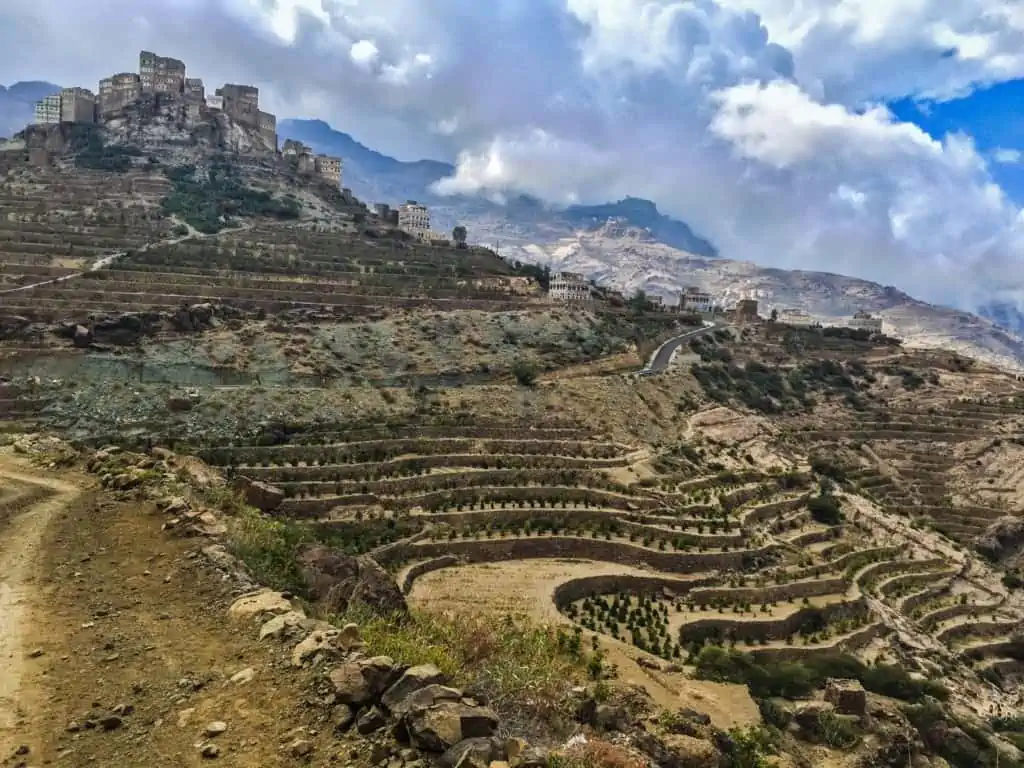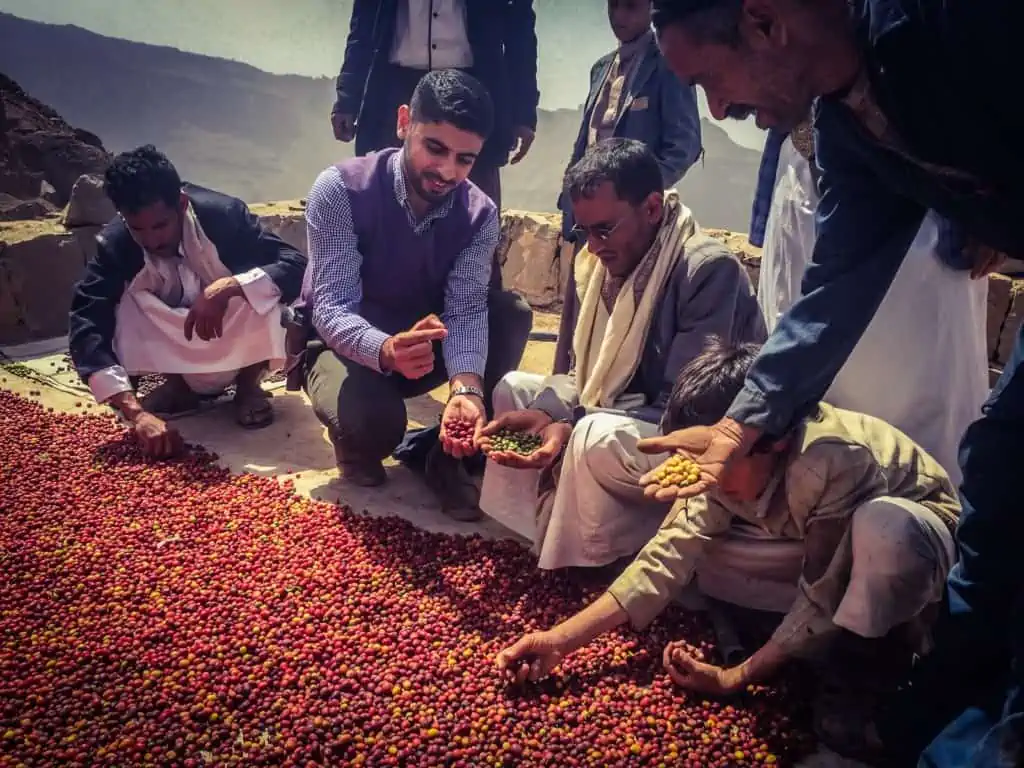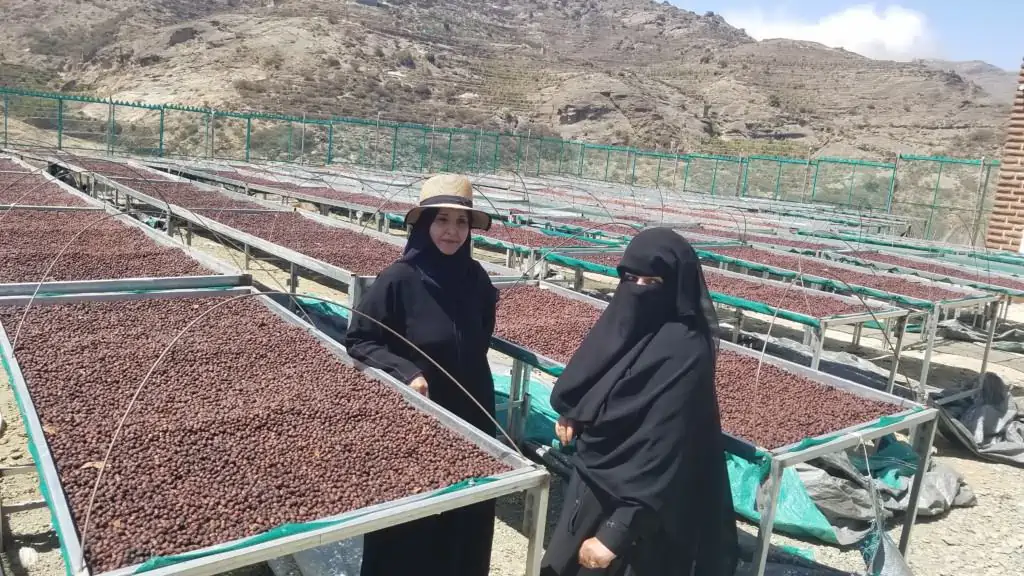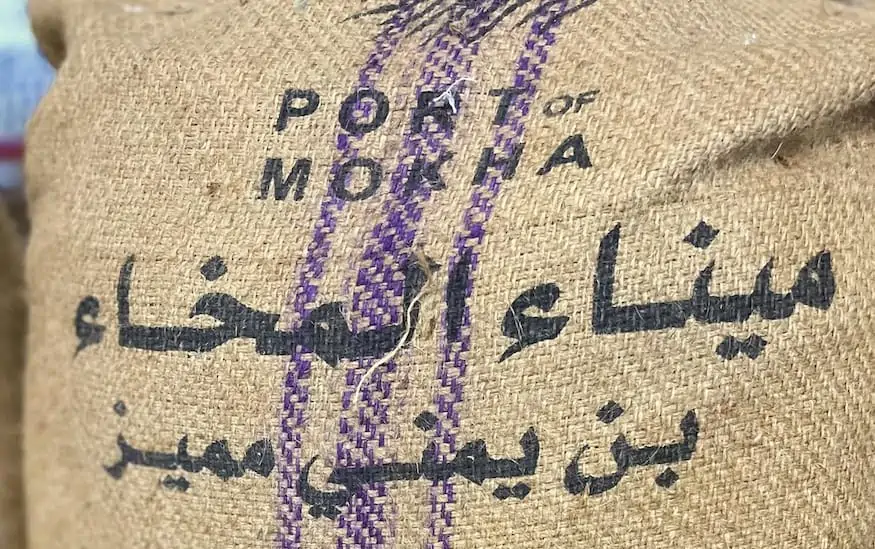
Coffee typically grows on steep terraced slopes in Yemen. Courtesy of Port of Mokha.
As most readers know, Yemen is the oldest continuously cultivated coffee in the world. The Coffea arabica tree originated in Ethiopia but was first systematically cultivated and commercialized in Yemen starting in about 1500. Until European colonists got into the game about 200 years later, Yemen produced virtually all of the coffee drunk in the world.
And, surprisingly, however, much coffee production practices changed as coffee spread from Yemen to the rest of the world, Yemen has stayed with its original, ancient methods. Most Yemen coffees today are still produced almost exactly as they have been for hundreds of years: The coffee fruit is picked and laid out to dry on rooftops, the dried fruit husks are split open with millstones, and the beans are winnowed and cleaned by hand. Until recently, the only changes in this ancient production method consisted of putting tarpaulins under the coffee fruit while it was drying and hitching the millstones to gasoline engines rather than draft animals.

Importer Mokhtar Alkhanshali and farmers demonstrate how unripe coffee fruit is removed from ripe before drying. Courtesy of Port of Mokha.
Meanwhile, the rest of the coffee world headed in a different direction with its production methods. The goal became clean, predictable-tasting coffees. The washed method, which involves removing the fruit from the freshly picked beans before they are dried to minimize the unpredictable impact of the fruit on the cup, became the norm for fine coffee in most of the world. Yemen’s handmade and consequently expensive and irregular-tasting coffees lost their way in a specialty world dominated by clean, dependable washed coffees.
There were enthusiasts who loved those unpredictable Yemen coffees, of course, and forward-thinking Yemeni coffee producers who continued to do their best to promote them. But by the early 2000s, it appeared that Yemen, stressed by regional power games, imported terrorism, homegrown civil conflict and proxy wars, might virtually stop exporting coffee altogether and end simply as a nostalgic chapter in coffee history.
A Turn Toward the Unique
But at around that same historical moment, high-end specialty coffee began to change, driven by a new market that rewarded uniqueness in coffee rather than simple consistency and predictability. Green coffee competitions and auctions began identifying highly differentiated coffees and rewarding them with higher and higher, sometimes outrageous, prices. A top lot of Geisha (also spelled Gesha), the famous Ethiopia-via-Panama coffee variety celebrated for its vivid, surprising cup character, recently sold at auction for a record-breaking price of $2,568 per pound, green and unroasted.
Yemen also fulfills another element in the new coffee paradigm: doing good by selling fine coffee. Yemen’s distinctive and storied coffee offers a modest yet clear opportunity to help some of Yemen’s people achieve more secure and stable lives by selling more of their coffee at higher prices. Six years into an armed civil conflict that has killed and injured over 18,000 civilians, Yemen remains the largest humanitarian crisis in the world. Over 20.1 million people—nearly two-thirds of the population—required food assistance at the beginning of 2020. So it is an understatement to point out that Yemen is a prime candidate for producing coffee that both tastes good and does good.
Add to this the fact that women don’t have basic human rights in Yemen, a fundamental problem that goes deeper than the current conflict. Unfortunately, we weren’t able to source roasted coffees from members of the International Women’s Coffee Alliance (IWCA), but there is a Yemen chapter. One longtime member, Sameeha Mohammed, regularly imports her fine Yemens to North America, which you can buy online at Sedna Coffee.

Yemen coffee producer Sameeha Mohamed and an associate at drying tables. Courtesy of Mery Santos, Sedna Coffee.
Importer/roaster Qima Coffee, whose Qima Foundation is the only non-profit organization in Yemen that works closely with smallholder coffee farmers, works with women from rural communities in the regions of Dhamar, Ibb and Mahwit to help establish and support women-farmer groups. Qima then pays premiums for this coffee to encourage more women-led participation in the supply chain and to ensure that women are fairly compensated for their work.
It would seem, then, that Yemen, with its varied cup, ancient tree varieties, high, dry terroirs, traditional processing methods, and dignified though struggling small-holding producers, is ready for its second star moment on the world coffee stage.
Good Press, Limited Volume
And, to some degree, it is beginning to claim that moment. The Monk of Mokha, an account by celebrated writer Dave Eggers of Yemeni-American Mokhtar Alkhanshali’s dramatic adventures in Yemen while setting up his successful coffee export-import business, was a New York Times best-seller in 2018. (We review four coffees imported by Alkhanshali’s company, Port of Mokha.) Green coffee auctions of Yemen coffees organized both by private exporters like Port of Mokha and by the Alliance for Coffee Excellence (ACE) have attracted impressive prices for elite lots of Yemen coffees.
Nevertheless, when we started contacting roasters and combing through websites looking for Yemen coffees to review that might be available now for consumers to buy and enjoy, we came up with a grand total of … 22! By way of comparison, when we went looking for coffees from Guatemala to cup for our September 2021 report, we easily ended with over 50 and probably could have sourced twice that number had we tried. Apparently, only a handful of exporter/importers appear able to master the challenges of sourcing and shipping top lots of Yemen coffee to markets outside the Middle East.
However, the 22 Yemen samples we received compensated for their limited number with high overall ratings: an average of around 90, with a high of 96 and a low of 85. Most displayed an impressive traditional range of Yemen coffee character, as well as some striking innovation. We review the nine highest-rated here.
What sensory pleasures and coffee insights can an enthusiast expect from these nine top-rated Yemens?
Taste Variations on the World’s Oldest Cup Profile, Intact yet Refined
Seven of these top-rated Yemens were processed using the ancient Yemen dried-in-the-fruit method, but with crucial refinements. They were produced from ripe fruit only, for example, rather than a mix of ripe and unripe, and were subject to controlled drying to prevent them from drying too quickly and turning flat or woody, a problem with some of the lower-rated among this month’s samples.

A bag of green coffee imported by Port of Mokha. Courtesy of Port of Mokha.
The best of these new/ancient Yemens were astonishing revelations of intricacy in aroma and flavor. All had flowers, all had fruit, often dark berries, all had variants on chocolate, all had aromatic wood notes almost incense-like in their complexity. Yet a single category of that array seldom dominated; most of the best natural-processed samples pretty much had most of it going on. Credit, perhaps, high growing elevations and semi-arid growing conditions, which encourage stressed trees with low yields of very dense beans. Or the ancient tree varieties. Or the careful conduct of the natural, in-the-fruit drying.
The most impressive in its aromatic intricacy is the 96-rated Port of Mokha Yemen Lot 106 from the very high-elevation Bait Alal community; reviewer Kim Westerman cites its “deep yet soaring, vertical complexity.” Two of these seven natural-processed samples displayed a surprising Kenya-like juxtaposition of savory depth and juicy liveliness: the Euphora Coffee Wadi Al Mahjr (95) and the Chromatic Port of Mokha Al Jabal (94). The Collage Yemen Mokha Matari (93) was a bit more idiosyncratic, with an earthy lean to the bittersweet structure and a sarsaparilla-like throughline; the Equator Coffees Yemen Sana’a (93) tilted toward earth and tobacco as well but juxtaposed with stone fruit and honeyish flowers. Finally, the Dragonfly Yemen Mocha Haimi (93) showed a gentle, round yet aromatically comprehensive side to the Yemen new natural cup.
Taste One of the World’s Newest Cup Profiles
If the seven coffees praised above represent successful refinements of the world’s most ancient processing method, we review two samples that represent the coffee world’s latest efforts to differentiate cup profile through increasingly elaborate variations in processing method. Like traditional Yemens, these two samples are natural coffees, dried in the whole fruit. But between picking and drying, they were subject to fermentation procedures designed to complicate or intensify the usually fruit-toned natural cup profile.
The Qima Coffee Bait Alal Community (93), despite being grown on centuries-old terraces surrounding a famous coffee village, was subject to a particularly elaborate processing sequence. Qima calls the approach its “alchemy method.” The whole coffee fruit proceeds through three kinds of ferment: first a conventional aerobic (with access to oxygen) stage, then a pressurized anaerobic stage (during which the fermenting fruit has no access to oxygen), and finally a fermentation stage in a darkened room, before the usual final slow drying.

Farmers and children in the Bait Alal community. Courtesy of Qima Coffee.
The result in the Bait Alal sample is a coffee with a distinctive, unconventional profile that seems to particularly reflect the impact of the anaerobic ferment stage, with a juicy yet tangy-tart lactic-acid character enveloped in tropical fruit sweetness. It is perhaps a polarizing profile that many coffee drinkers will prize for its originality and bright, perfumy intensity (these coffee lovers might argue for a rating higher than our 93) while others may find it intriguing but perhaps a bit cloying in its fruit-toned sweetness and yogurty lactic hints, and feel that our 93 is too generous.
One other coffee we review this month also went through an anaerobic or limited-oxygen fermentation stage, the Port of Mokha Al Wadi (94). The method here was much simpler, involving a single anaerobic ferment of the whole coffee fruit in a sealed vessel before slow drying. In this case, the lactic-acid influence of the anaerobic processing shows more as a backgrounded complication to a big, resonant profile: floral, date-toned and pungently chocolaty.
Taste Coffee Varieties Grown Nowhere Else in the World
Most Yemen coffee is produced from coffee varieties grown in the region for a very long time, perhaps centuries. Until now, these varieties have been known only by the set of traditional, rather folkloric names assigned to them by local coffee tradition. However, earlier this year a study was published describing the results of genetic fingerprinting of 137 samples of Yemen coffee drawn from an area of over 25,000 square kilometers. Along with a surprising number of the world’s other cultivated Arabica varieties, including indigenous Ethiopia varieties, the researchers turned up “an entirely new set of genetics” unique to Yemen. In other words, they found coffee trees growing in Yemen with genetics that do not match the genetic footprints of coffee plants growing anywhere else in the world, including Ethiopia, the presumed home of Arabica.
The researchers referred to the newly identified Yemen-only material as the “new-Yemen cluster,” but importer/roaster Qima Coffee, in the context of an Alliance for Coffee Excellence (ACE) auction, has publicized and promoted this genetic cluster under the name “Yemenia”. According to Faris Sheibani, Founder and CEO of Qima, the name Yemenia was proposed “so that farmers can identify the genetic uniqueness of their coffees and capture the value that is associated with that uniqueness.” He adds that the name Yemenia “is free for use by any Yemeni trader, exporter, cooperative and farmer and exists for the benefit of the industry.”
Nevertheless, many farmers and their more conventional exporter partners may stick with traditional names for their tree varieties for now. In either case, however, exceptional Yemen coffees like those we review in this report are likely to have been produced from tree varieties unique in the world of coffee.
Test the Chocolate Myth
In traditional coffee lore, Yemens are reputed to taste chocolaty. It is said that that this tendency is what caused some imaginative beverage-namer to start calling drinks composed of coffee and chocolate “Mocha,” using the common name applied to Yemen coffees up through the mid-20th century. Many Yemens in this month’s small sampling do display chocolate notes, although complexly and variously: dry baking chocolate, rich dark chocolate, sweet-toned cocoa, nut-like cocoa nib. Many samples also showed a tendency to display rich wood tones – cedar, in particular. We hardly cupped enough samples to speculate on the reasons for this twin tendency. Chocolate, in general, appears to be associated with the impact of roasting on fruit notes, and Yemens, always dried in the whole fruit, usually provide the needed fruit. Wood notes were a common thread through virtually all of the samples, but in the best, the wood tended to be complex and rich, often cedary, rather than simple and flat.
Ancient Origin, Barely Tapped Potential
After sampling this handful of often brilliant coffees, it is hard not to conclude that Yemen’s potential as a source of fine coffees in the distinctive contemporary mode has barely been tapped. Virtually all of this month’s top-rated coffees came from traditional coffee-growing regions situated in the high mountain growing regions west of the capital, Sana’a. Four are from the same famous coffee community, Bait Alal. But considerable coffee is grown elsewhere in Yemen. Among exporters to the U.S., Europe and Asia, perhaps only Qima Coffee may be well-connected and well-funded enough to cast a wide geographical net for fine Yemen coffee. However, Qima’s main focus, for now, appears to be raising awareness of Yemen coffee through competitions and auctions rather than supplying coffee lovers with a range of fine roasted Yemens.
Hopefully, as the devastating civil and proxy conflicts in Yemen diminish and the word gets out to coffee enthusiasts, this singular coffee origin will fully emerge into the spotlight of its second starring appearance on the world coffee stage.










